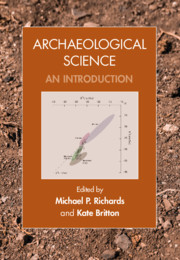Book contents
- Archaeological Science
- Archaeological Science
- Copyright page
- Contents
- Figures
- Tables
- Contributors
- Acknowledgements
- Part I Introduction
- Part II Biomolecular Archaeology
- 2 Ancient DNA
- 3 Proteomics
- 4 Residue Analysis
- 5 Isotope Analysis for Mobility and Climate Studies
- 6 Isotope Analysis for Diet Studies
- Part III Bioarchaeology
- Part IV Environmental Archaeology
- Part V Materials Analysis
- Part VI Absolute Dating Methods
- Index
- References
4 - Residue Analysis
from Part II - Biomolecular Archaeology
Published online by Cambridge University Press: 19 December 2019
- Archaeological Science
- Archaeological Science
- Copyright page
- Contents
- Figures
- Tables
- Contributors
- Acknowledgements
- Part I Introduction
- Part II Biomolecular Archaeology
- 2 Ancient DNA
- 3 Proteomics
- 4 Residue Analysis
- 5 Isotope Analysis for Mobility and Climate Studies
- 6 Isotope Analysis for Diet Studies
- Part III Bioarchaeology
- Part IV Environmental Archaeology
- Part V Materials Analysis
- Part VI Absolute Dating Methods
- Index
- References
Summary
Residue analysis, as used in archaeology, is a generic term used to describe the characterisation of traces of organic products from the past. This chapter is concerned with organic residues that are commonly encountered bound to, adhered to or absorbed within a mineral artefact, such as a ceramic vessel or a stone tool. Methods of analysis are varied and range from microscopic identification of remnant tissue fragments to chemical and structural analysis of the major classes of biomolecules, such as lipids, proteins and DNA. This chapter aims to provide the reader with a broad overview of the composition of residues associated with artefacts, their formation and preservation, the principal methods of analysis and to demonstrate the impact that this field has made for understanding the use of artefacts in the past. For more detailed overviews of the occurrence and analysis of specific biomolecules in archaeology, readers are directed to Evershed et al. (2001), Evershed (2008a) and Pollard and Heron (2008) for lipids; Hendy et al. (2001), Pollard and Heron (2008), Colombini and Modugno (2009) and Regert (2011) also provide a comprehensive description of lipid residue analysis of artefacts.
Information
- Type
- Chapter
- Information
- Archaeological ScienceAn Introduction, pp. 70 - 98Publisher: Cambridge University PressPrint publication year: 2020
References
Accessibility standard: Unknown
Why this information is here
This section outlines the accessibility features of this content - including support for screen readers, full keyboard navigation and high-contrast display options. This may not be relevant for you.Accessibility Information
- 5
- Cited by
